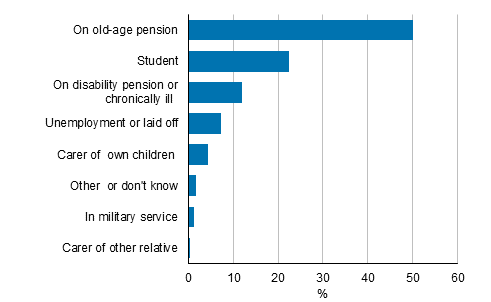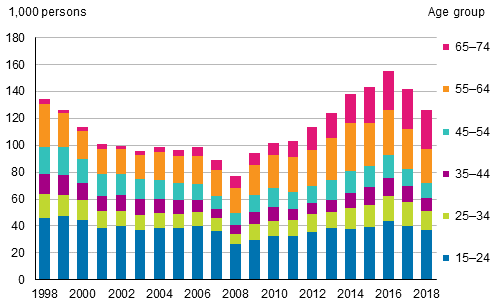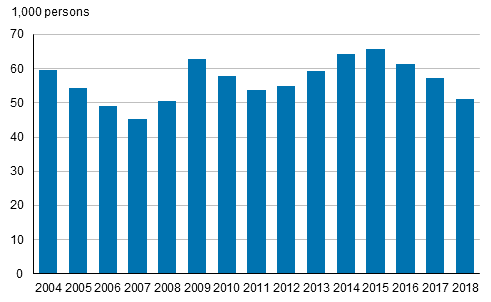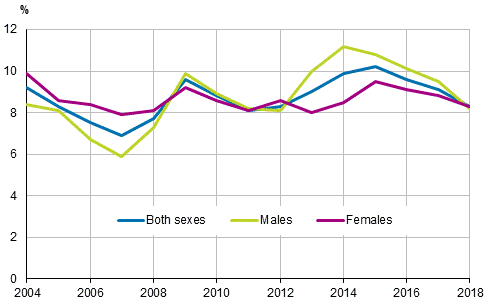4 Inactive population
4.1 Around one-third of the population in the inactive population in 2018
In 2018, there were 1,382,000 persons in the inactive population, or 34 per cent of persons aged 15 to 74. The number was 24,000 lower than in 2017. The size of the inactive population decreased most in the 55 to 64 age group, by 19,000 persons. In the Labour Force Survey, the inactive population refers to persons who were not employed or unemployed during the survey week. Those in military service are also included in the inactive population.
In the Labour Force Survey, data concerning main type of activity are based on the respondent's own reporting. The majority of them, 62 per cent, reported they were on old-age or disability pension or chronically ill in 2018. Of the inactive population, 22 per cent reported they were students or pupils. Five per cent were caring for their own children or some other relative. (Figure 20.)
Figure 20. Persons in the inactive population by main activity* in 2018, persons aged 15 to 74, %

*) Data concerning main type of activity are based on the respondent’s own reporting
4.2 Number of persons in disguised unemployment continued decreasing
Persons in the inactive population who would want gainful work and would be available for work within a fortnight, but who have not looked for work in the past four weeks are considered persons in disguised unemployment in the Labour Force Survey. Persons in disguised unemployment can be considered as potential additional labour force.
There were a total 128,000 persons aged 15 to 74 in disguised unemployment in 2018, down by 15,000 from the year before. The number of persons in disguised unemployment decreased for the second year in a row. (Figure 21.)
Studying was the most common reason for persons in disguised unemployment not seeking employment. It was reported as the reason by 25 per cent of persons in disguised unemployment. From 2009, the most common reason not to seek employment was the assumption that no work is available, which was given as the reason by 21 per cent of persons in disguised unemployment in 2018.
In 2018, like in previous years, most persons in disguised unemployment were found in the 15 to 24 age group, in total 37,000 persons. Persons in disguised unemployment were the second most numerous among those aged 65 to 74, that is, 29,000. Good one-half of them thought they had already retired completely. Of persons aged 55 to 64, there were 25,000 in disguised unemployment, of whom 35 per cent did not believe they could not find a job.
Figure 21. Persons in disguised unemployment by age group in 1998 to 2018, persons

4.3 Eight per cent of young people outside work and education
This Section describes such persons aged 15 to 24 who are not employed and have not participated in any type of education in four weeks before the survey and who are not performing compulsory military service either. Here, participation in education refers to both education leading to a qualification and participation in various types of courses.
In 2018, there were a total of 51,000 young people not working, studying or performing compulsory military service, which represented eight per cent of the entire 15 to 24 age group. The majority of them, 38,000, were aged between 20 and 24. The number of young people outside work and education in the age group decreased by 6,000 persons, or by 11 per cent from 2017. (Figure 22.)
Figure 22. Young people aged 15 to 24 who were not working, studying or performing compulsory military service in 2004 to 2018

During the past five years, the share of men among those not working, studying or performing compulsory military service has been bigger than the corresponding share of women in the same-age population. For men, the share had fallen starting from 2014 and for women from 2015. In 2018, men's share fell nearly to the same level as women's. In all, the share of persons aged 15 to 24 not working, studying or performing compulsory military service fell in 2018 to the same level it was last in 2008. (Figure 23.)
Figure 23. Share of persons aged 15 to 24 not working, studying or performing compulsory military service in the population of the same age in 2004 to 2018, %

Source: Labour Force Survey 2018. Statistics Finland
Inquiries: Ulla Hannula 029 551 2924, Tatu Leskinen 029 551 3285, tyovoimatutkimus@stat.fi
Director in charge: Jari Tarkoma
Updated 11.4.2019
Official Statistics of Finland (OSF):
Labour force survey [e-publication].
ISSN=1798-7857. Time series data 2009-2018 2018,
4 Inactive population
. Helsinki: Statistics Finland [referred: 19.4.2025].
Access method: http://stat.fi/til/tyti/2018/13/tyti_2018_13_2019-04-11_kat_004_en.html

